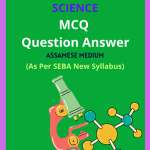Class 8 Science MCQ Chapter 6 Combustion and Flame Solutions in English Medium, Class 8 Science Multiple Choice Question Answer in English to each chapter is provided in the list so that you can easily browse throughout different chapters Class 8 Science MCQ Chapter 6 Combustion and Flame Notes and select need one.
Class 8 Science MCQ Chapter 6 Combustion and Flame
Also, you can read the SCERT book online in these sections Class 8 Science Objective Type Solutions by Expert Teachers as per SCERT (CBSE) Book guidelines. These solutions are part of SCERT All Subject Solutions. Here we have given Assam Class 8 Science MCQs Solutions in English for All Subject, You can practice these here.
Combustion and Flame
Chapter – 6
| MCQ |
1. Which zone of a candle flame is least hot?
(a) Outer zone.
(b) Middle zone.
(c) Inner zone.
(d) All zones are equally hot.
Ans: (c) Inner zone.
2. Which fuel is considered the cleanest burning fossil fuel?
(a) Coal.
(b) Diesel.
(c) Natural gas.
(d) Petrol.
Ans: (c) Natural gas.
3. Which device is used to measure the heat produced by combustion?
(a) Thermometer.
(b) Calorimeter.
(c) Hygrometer.
(d) Barometer.
Ans: (b) Calorimeter.
4. Which of the following is a solid fuel?
(a) LPG.
(b) Petrol.
(c) Kerosene.
(d) Charcoal.
Ans: (d) Charcoal.
5. What is the flash point of a substance?
(a) The temperature at which it ignites spontaneously.
(b) The temperature at which it gives off enough vapour to ignite.
(c) The temperature at which it becomes a liquid.
(d) The temperature at which it becomes a gas.
Ans: (b) The temperature at which it gives off enough vapour to ignite.
6. Which of the following is a characteristic of a luminous flame?
(a) Blue in colour.
(b) Yellow in colour.
(c) Produces more heat.
(d) Indicates complete combustion.
Ans: (b) Yellow in colour.
7. What is the main component of biogas?
(a) Methane.
(b) Propane.
(c) Butane.
(d) Ethane.
Ans: (a) Methane.
8. Which substance is used to extinguish fire in oil wells?
(a) Water.
(b) Carbon dioxide.
(c) Mud.
(d) Foam.
Ans: (c) Mud.
9. What is the term for the energy produced by burning a fuel?
(a) Thermal energy.
(b) Chemical energy.
(c) Light energy.
(d) Kinetic energy.
Ans: (a) Thermal energy.
10. Which of the following is a characteristic of a non-luminous flame?
(a) Yellow in colour.
(b) Produces more soot.
(c) Blue in colour.
(d) Indicates incomplete combustion.
Ans: (c) Blue in colour.
11. Which is the most common fire extinguisher used for small fires?
(a) Water extinguisher.
(b) Carbon dioxide extinguisher.
(c) Foam extinguisher.
(d) Powder extinguisher.
Ans: (d) Powder extinguisher.
12. Which of the following is not a necessary condition for combustion?
(a) Fuel.
(b) Heat.
(c) Water.
(d) Oxygen.
Ans: (c) Water.
13. Which type of combustion occurs on its own without external heat?
(a) Spontaneous combustion.
(b) Rapid combustion.
(c) Slow combustion.
(d) None of the above.
Ans: (a) Spontaneous combustion.
14. Which gas is commonly known as the supporter of combustion?
(a) Nitrogen.
(b) Carbon dioxide.
(c) Oxygen.
(d) Hydrogen.
Ans: (c) Oxygen.
15. Which of the following is used as a fire extinguisher for electrical fires?
(a) Water.
(b) Carbon dioxide.
(c) Sand.
(d) Foam.
Ans: (b) Carbon dioxide.

Hi! my Name is Parimal Roy. I have completed my Bachelor’s degree in Philosophy (B.A.) from Silapathar General College. Currently, I am working as an HR Manager at Dev Library. It is a website that provides study materials for students from Class 3 to 12, including SCERT and NCERT notes. It also offers resources for BA, B.Com, B.Sc, and Computer Science, along with postgraduate notes. Besides study materials, the website has novels, eBooks, health and finance articles, biographies, quotes, and more.




